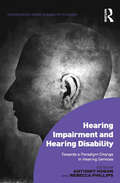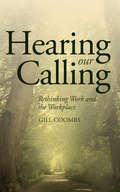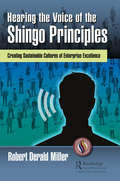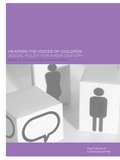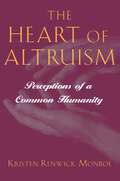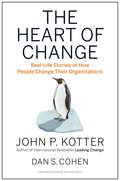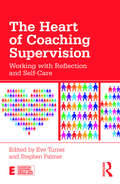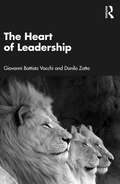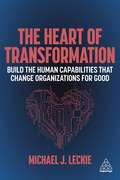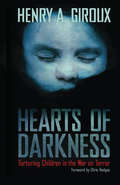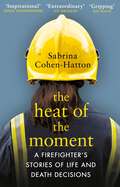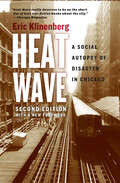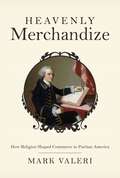- Table View
- List View
Hearing Impairment and Hearing Disability: Towards a Paradigm Change in Hearing Services (Interdisciplinary Disability Studies)
by Rebecca Phillips Anthony HoganThe purpose of this book is to challenge people (service providers, people with a hearing disability and those who advocate for them) to reconsider the way western society thinks about hearing disability and the way it seeks to 'include them’. It highlights the concern that the design of hearing services is so historically marinated in ableist culture that service users often do not realise they may be participating in their own oppression within a phono-centric society. With stigma and marginalisation being the two most critical issues impacting on people with hearing disability, Hogan and Phillips document both the collective and personal impacts of such marginality. In so doing, the book brings forward an argument for a paradigm shift in hearing services. Drawing upon the latest research and policy work, the book opens up a conceptual framework for a new approach to hearing services and looks at the kinds of personal and systemic changes a paradigm shift would entail.
Hearing Our Calling: Rethinking Work and the Workplace
by Gill CoombsFor many of us, work is a source of anxiety rather than joy, and our workplace routine has become a strain on our lives. This unique book explores whether it's possible to develop a world of work which is, in fact, joyful, fulfilling and good for our health. Insightful and practical, Hearing our Calling traces the history of work, challenging current work practices and routines we take for granted. Drawing on her extensive work with different organisations, the author exposes the corporate world and reveals a surprising and beautiful alternative. She argues that we all have a 'calling', and that hearing it is especially important in times of widespread unemployment and economic hardship. This lucid and readable book invites us to think differently about how and where we work, both individually and as a society, and offers the potential for real change.
Hearing the Voice of the Shingo Principles: Creating Sustainable Cultures of Enterprise Excellence
by Robert Derald MillerFor more than 50 years, organizations of all types have struggled to achieve lasting benefits from the many tools and programs associated with various continuous-improvement initiatives. In fact, the notion of "continuous" improvement is largely a misnomer -- for many organizations, continuous improvement has been anything but continuous. Responding to this challenge, Hearing the Voice of the Shingo Principles chronicles key insights that went into development of the Shingo Model for Operational Excellence at Utah State University. While responsible for the Shingo Prize at USU, the author observed that even recipients -- theoretically, the best of the best -- were experiencing this same up-and-down phenomenon. It was as though many of these organizations were reviewed on their very best days but then started declining from that point forward. To build long-term credibility of the Shingo Prize, the author and his team had to understand what was causing such wide variation in results and make certain they were only recognizing those organizations that could demonstrate sustainability of improvements over the long term. They found that sustainability depended less on application of the tools for improvement than on embedding principles deep into the culture of the organization from top to bottom and side to side. This book helps leaders understand their role in building sustainable cultures of enterprise excellence – That is, how to keep the entire enterprise focused on guiding principles that will change beliefs, behaviors, and the overall mindset. In addition, managers will learn how to align systems with principles so that they drive ideal, principle-based behaviors – the goal is for every leader to realign their values with the voice of principles and become an example so that every associate becomes self-motivated to continuously improve every aspect for which they are accountable.
Hearing the Voice of the Shingo Principles: Creating Sustainable Cultures of Enterprise Excellence
by Robert Derald MillerFor more than 50 years, organizations of all types have struggled to achieve lasting benefits from the many tools and programs associated with various continuous-improvement initiatives. In fact, the notion of "continuous" improvement is largely a misnomer -- for many organizations, continuous improvement has been anything but continuous. Responding to this challenge, Hearing the Voice of the Shingo Principles chronicles key insights that went into development of the Shingo Model for Operational Excellence at Utah State University. While responsible for the Shingo Prize at USU, the author observed that even recipients -- theoretically, the best of the best -- were experiencing this same up-and-down phenomenon. It was as though many of these organizations were reviewed on their very best days but then started declining from that point forward. To build long-term credibility of the Shingo Prize, the author and his team had to understand what was causing such wide variation in results and make certain they were only recognizing those organizations that could demonstrate sustainability of improvements over the long term. They found that sustainability depended less on application of the tools for improvement than on embedding principles deep into the culture of the organization from top to bottom and side to side. This book helps leaders understand their role in building sustainable cultures of enterprise excellence – That is, how to keep the entire enterprise focused on guiding principles that will change beliefs, behaviors, and the overall mindset. In addition, managers will learn how to align systems with principles so that they drive ideal, principle-based behaviors – the goal is for every leader to realign their values with the voice of principles and become an example so that every associate becomes self-motivated to continuously improve every aspect for which they are accountable.
Hearing the Voices of Children: Social Policy for a New Century
by Christine Hallett Alan ProutHearing the Voices of Children provides a fresh perspective on social policy. At the heart of the book is the emergence of 'children's voices' and the implications of this for social policy. The authors argue that children's voices should be heard much more strongly in the process of policy formation at all levels. Although there is growing support for this idea, it is not without opposition, and the authors themselves make many critical points about the current attempts to put it into practice.The book is divided into four main themes: hearing children's voices; discourses of childhood; children and services; and resources for children. Childhood experts from the UK, Scandinavia, Germany and Australia, examine how assumptions and models about childhood and discuss ways in which children's voices might become more influential in shaping policy. There are many obstacles to overcome, but the contributors to this volume show that children's participation is possible, and needed, if services are to be improved.This book is essential reading for students and academics in the field of childhood studies, sociology, social policy and education. It will also be of interest to practitioners in the social, child and youth services.
Hearing the Voices of Children: Social Policy for a New Century (Future Of Childhood Ser.)
by Christine Hallett Alan ProutHearing the Voices of Children provides a fresh perspective on social policy. At the heart of the book is the emergence of 'children's voices' and the implications of this for social policy. The authors argue that children's voices should be heard much more strongly in the process of policy formation at all levels. Although there is growing support for this idea, it is not without opposition, and the authors themselves make many critical points about the current attempts to put it into practice.The book is divided into four main themes: hearing children's voices; discourses of childhood; children and services; and resources for children. Childhood experts from the UK, Scandinavia, Germany and Australia, examine how assumptions and models about childhood and discuss ways in which children's voices might become more influential in shaping policy. There are many obstacles to overcome, but the contributors to this volume show that children's participation is possible, and needed, if services are to be improved.This book is essential reading for students and academics in the field of childhood studies, sociology, social policy and education. It will also be of interest to practitioners in the social, child and youth services.
The Heart of Altruism: Perceptions of a Common Humanity
by Kristen Renwick MonroeIs all human behavior based on self-interest? Many social and biological theories would argue so, but such a perspective does not explain the many truly heroic acts committed by people willing to risk their lives to help others. In The Heart of Altruism, Kristen Renwick Monroe boldly lays the groundwork for a social theory receptive to altruism by examining the experiences described by altruists themselves: from Otto, a German businessman who rescued over a hundred Jews in Nazi Germany, to Lucille, a newspaper poetry editor, who, armed with her cane, saved a young girl who was being raped. Monroe's honest and moving interviews with these little-known heroes enable her to explore the causes of altruism and the differences between altruists and other people. By delineating an overarching perspective of humanity shared by altruists, Monroe demonstrates how social theories may begin to account for altruism and debunks the notions of scientific inevitability that stem from an overemphasis on self-interest. As Monroe has discovered, the financial and religious backgrounds of altruists vary greatly--as do their views on issues such as welfare, civil rights, and morality. Altruists do, however, share a certain way of looking at the world: where the rest of us see a stranger, altruists see a fellow human being. It is this perspective that many social theories overlook. Monroe restores altruism to a general theory of ethical political behavior. She argues that to understand what makes one person act out of concern for others and not the self, we need to ask how that individual's perspective sets the range of options he or she finds available.
The Heart of Altruism: Perceptions of a Common Humanity
by Kristen Renwick MonroeIs all human behavior based on self-interest? Many social and biological theories would argue so, but such a perspective does not explain the many truly heroic acts committed by people willing to risk their lives to help others. In The Heart of Altruism, Kristen Renwick Monroe boldly lays the groundwork for a social theory receptive to altruism by examining the experiences described by altruists themselves: from Otto, a German businessman who rescued over a hundred Jews in Nazi Germany, to Lucille, a newspaper poetry editor, who, armed with her cane, saved a young girl who was being raped. Monroe's honest and moving interviews with these little-known heroes enable her to explore the causes of altruism and the differences between altruists and other people. By delineating an overarching perspective of humanity shared by altruists, Monroe demonstrates how social theories may begin to account for altruism and debunks the notions of scientific inevitability that stem from an overemphasis on self-interest. As Monroe has discovered, the financial and religious backgrounds of altruists vary greatly--as do their views on issues such as welfare, civil rights, and morality. Altruists do, however, share a certain way of looking at the world: where the rest of us see a stranger, altruists see a fellow human being. It is this perspective that many social theories overlook. Monroe restores altruism to a general theory of ethical political behavior. She argues that to understand what makes one person act out of concern for others and not the self, we need to ask how that individual's perspective sets the range of options he or she finds available.
The Heart Of Change
by John P. Kotter Dan S. CohenWhy is change so hard? Because in order to make any transformation successful, you must change more than just the structure and operations of an organization—you need to change people’s behavior. And that is never easy. The Heart of Change is your guide to helping people think and feel differently in order to meet your shared goals. According to bestselling author and renowned leadership expert John Kotter and coauthor Dan Cohen, this focus on connecting with people’s emotions is what will spark the behavior change and actions that lead to success. Now freshly designed, The Heart of Change is the engaging and essential complement to Kotter’s worldwide bestseller Leading Change. Building off of Kotter’s revolutionary eight-step process, this book vividly illustrates how large-scale change can work. With real-life stories of people in organizations, the authors show how teams and individuals get motivated and activated to overcome obstacles to change—and produce spectacular results. Kotter and Cohen argue that change initiatives often fail because leaders rely too exclusively on data and analysis to get buy-in from their teams instead of creatively showing or doing something that appeals to their emotions and inspires them to spring into action. They call this the see-feel-change dynamic, and it is crucial for the success of any true organizational transformation. Refreshingly clear and eminently practical, The Heart of Change is required reading for anyone facing the challenges inherent in leading change.
The Heart Of Change (PDF)
by John P. Kotter Dan S. CohenWhy is change so hard? Because in order to make any transformation successful, you must change more than just the structure and operations of an organization—you need to change people’s behavior. And that is never easy. The Heart of Change is your guide to helping people think and feel differently in order to meet your shared goals. According to bestselling author and renowned leadership expert John Kotter and coauthor Dan Cohen, this focus on connecting with people’s emotions is what will spark the behavior change and actions that lead to success. Now freshly designed, The Heart of Change is the engaging and essential complement to Kotter’s worldwide bestseller Leading Change. Building off of Kotter’s revolutionary eight-step process, this book vividly illustrates how large-scale change can work. With real-life stories of people in organizations, the authors show how teams and individuals get motivated and activated to overcome obstacles to change—and produce spectacular results. Kotter and Cohen argue that change initiatives often fail because leaders rely too exclusively on data and analysis to get buy-in from their teams instead of creatively showing or doing something that appeals to their emotions and inspires them to spring into action. They call this the see-feel-change dynamic, and it is crucial for the success of any true organizational transformation. Refreshingly clear and eminently practical, The Heart of Change is required reading for anyone facing the challenges inherent in leading change.
The Heart of Coaching Supervision: Working with Reflection and Self-Care (Essential Coaching Skills and Knowledge)
by Eve Turner Stephen PalmerThe Heart of Coaching Supervision takes us on a journey that starts with understanding who we are, and why we do what we do the way we do it, so that we can help those we work with understand themselves and their practice. The journey includes our background and personal and professional influences and considers the need for self-resourcing to resource others. It examines our being alongside our doing, to ensure that we can provide the best possible service to all those we work with. The book’s highly experienced contributors provide a unique perspective on supervision’s benefits. The chapters cover themes that support self-discovery and resourcing including the three Ps of supervision and coaching, diversity and inclusion, resourcing, working with intense emotions and the self as instrument. Nancy Kline’s Thinking Environment© is explored in a supervision context alongside creative forms of reflective and expressive writing and resourcing through a peer supervision chain. The Heart of Coaching Supervision also includes ten engaging, international case studies, considering the role of supervision in depth. A key contribution to the field, the book is essential reading for all coaches and mentors, coaching supervisors and psychologists, managers in a coaching role and anyone in a helping profession or leadership position wanting to better understand the wide benefits of supervision.
The Heart of Coaching Supervision: Working with Reflection and Self-Care (Essential Coaching Skills and Knowledge)
by Eve Turner Stephen PalmerThe Heart of Coaching Supervision takes us on a journey that starts with understanding who we are, and why we do what we do the way we do it, so that we can help those we work with understand themselves and their practice. The journey includes our background and personal and professional influences and considers the need for self-resourcing to resource others. It examines our being alongside our doing, to ensure that we can provide the best possible service to all those we work with. The book’s highly experienced contributors provide a unique perspective on supervision’s benefits. The chapters cover themes that support self-discovery and resourcing including the three Ps of supervision and coaching, diversity and inclusion, resourcing, working with intense emotions and the self as instrument. Nancy Kline’s Thinking Environment© is explored in a supervision context alongside creative forms of reflective and expressive writing and resourcing through a peer supervision chain. The Heart of Coaching Supervision also includes ten engaging, international case studies, considering the role of supervision in depth. A key contribution to the field, the book is essential reading for all coaches and mentors, coaching supervisors and psychologists, managers in a coaching role and anyone in a helping profession or leadership position wanting to better understand the wide benefits of supervision.
The Heart of Leadership
by Giovanni Battista Vacchi Danilo ZattaSquarely aimed at leaders and aspiring leaders, The Heart of Leadership, written by two renowned management experts, presents practical examples and engaging insights to answer the key question of how to be a successful leader.This book reveals the key characteristics of a great leader and shows you how to develop the skills needed to motivate your team and overcome challenges. Leadership means successfully taking your place at the head of an enterprise and is both a shared journey and an adventure over the course of a career. Using an engaging and accessible style throughout, the book maps out how to achieve tangible results. It presents portrayals of some of history’s greatest leaders, from Gandhi to Steve Jobs, from Angela Merkel to Lisa Su, in order to inspire and help develop your own top leadership skills.This book is essential reading for CEOs, CFOs, HR managers, entrepreneurs, trainers, and those who are seeking a leadership position in an organization and want to understand how to succeed within it.
The Heart of Leadership
by Giovanni Battista Vacchi Danilo ZattaSquarely aimed at leaders and aspiring leaders, The Heart of Leadership, written by two renowned management experts, presents practical examples and engaging insights to answer the key question of how to be a successful leader.This book reveals the key characteristics of a great leader and shows you how to develop the skills needed to motivate your team and overcome challenges. Leadership means successfully taking your place at the head of an enterprise and is both a shared journey and an adventure over the course of a career. Using an engaging and accessible style throughout, the book maps out how to achieve tangible results. It presents portrayals of some of history’s greatest leaders, from Gandhi to Steve Jobs, from Angela Merkel to Lisa Su, in order to inspire and help develop your own top leadership skills.This book is essential reading for CEOs, CFOs, HR managers, entrepreneurs, trainers, and those who are seeking a leadership position in an organization and want to understand how to succeed within it.
The Heart of Transformation: Build the Human Capabilities that Change Organizations for Good
by Michael J. LeckieTechnology doesn't transform organizations - people do.In an era of technological and constant change, companies are bombarded with urgent advice to become more agile, lean and digital. Billions are spent on digital transformation efforts with the promise that these efforts will increase competitive advantage. Yet even when only 30 percent of these efforts succeed, this hard-won competitive advantage only lasts until the next disruption before the cycle repeats, causing transformation fatigue. The Heart of Transformation breaks this cycle by suggesting that the pace and complexity of change is too great and too complex to be addressed by a single change effort or transformation. The answer lies in the organization's greatest asset: its people. In the face of complexity, it is the people and their ability to adapt and learn that are the true engine of organizational change. The Heart of Transformation outlines the six human capabilities (Exploring before Executing, Learning before Knowing, Pathfinding before Path Following, Changing before Protecting, Innovating before Replicating and Humanizing before Organizing) that create competitive advantage for organizations organically, quickly and from the bottom up. The book translates those capabilities into simple and immediately adoptable behaviors for leaders and every person in the organization. It offers a new standard for organizational excellence, one that is dependent on the organization's ability to be deeply human. Instead of offering another one-size-fits-all solution, The Heart of Transformation reveals that by leveraging our most human of capabilities, organizations can change better, faster and achieve excellence much quicker than imagined.
The Heart of Transformation: Build the Human Capabilities that Change Organizations for Good
by Michael J. LeckieTechnology doesn't transform organizations - people do.In an era of technological and constant change, companies are bombarded with urgent advice to become more agile, lean and digital. Billions are spent on digital transformation efforts with the promise that these efforts will increase competitive advantage. Yet even when only 30 percent of these efforts succeed, this hard-won competitive advantage only lasts until the next disruption before the cycle repeats, causing transformation fatigue. The Heart of Transformation breaks this cycle by suggesting that the pace and complexity of change is too great and too complex to be addressed by a single change effort or transformation. The answer lies in the organization's greatest asset: its people. In the face of complexity, it is the people and their ability to adapt and learn that are the true engine of organizational change. The Heart of Transformation outlines the six human capabilities (Exploring before Executing, Learning before Knowing, Pathfinding before Path Following, Changing before Protecting, Innovating before Replicating and Humanizing before Organizing) that create competitive advantage for organizations organically, quickly and from the bottom up. The book translates those capabilities into simple and immediately adoptable behaviors for leaders and every person in the organization. It offers a new standard for organizational excellence, one that is dependent on the organization's ability to be deeply human. Instead of offering another one-size-fits-all solution, The Heart of Transformation reveals that by leveraging our most human of capabilities, organizations can change better, faster and achieve excellence much quicker than imagined.
Hearts of Darkness: Torturing Children in the War on Terror
by Henry A. GirouxGeorge W. Bush's war on terror defended torture as a matter of official policy and furthered an already emergent culture of cruelty. As torture became normalized in the Bush era, it not only corrupted American ideals and political culture, it also passed over to the dark side in sanctioning the unimaginable and unspeakable: the torture of children. This shocking book documents cases of child torture by American military personnel, many of which have never been reported in the media. Giroux raises serious challenges the Obama administration must address in light of this shameful period in American history if it wants to restore democratic culture. Going further than simply blaming those at the top, Hearts of Darkness also raises questions about the collusion of the media, educators, the criminal justice system and other institutions that have enabled a culture that accepts the torture of children.
Hearts of Darkness: Torturing Children in the War on Terror
by Henry A. GirouxGeorge W. Bush's war on terror defended torture as a matter of official policy and furthered an already emergent culture of cruelty. As torture became normalized in the Bush era, it not only corrupted American ideals and political culture, it also passed over to the dark side in sanctioning the unimaginable and unspeakable: the torture of children. This shocking book documents cases of child torture by American military personnel, many of which have never been reported in the media. Giroux raises serious challenges the Obama administration must address in light of this shameful period in American history if it wants to restore democratic culture. Going further than simply blaming those at the top, Hearts of Darkness also raises questions about the collusion of the media, educators, the criminal justice system and other institutions that have enabled a culture that accepts the torture of children.
The Heat of the Moment: Life and Death Decision-Making From a Firefighter
by Dr Sabrina Cohen-Hatton______AS SEEN ON BBC BREAKFAST'[One of] the wonder women of our emergency services' Glamour'Does for the fire service what Adam Kay’s This is Going to Hurt did for the NHS. A humbling, jaw-dropping read which redefines what is possible' Viv GroskopIn the face of urgency and uncertainty, would you respond analytically or trust your instincts? How would you decide who lives and who dies?Dr Sabrina Cohen-Hatton has been a firefighter for eighteen years. She decides which of her colleagues rush into a burning building and how they confront the blaze. She makes the call to evacuate if she believes the options have been exhausted or that the situation has escalated beyond hope. This is her astonishing account of a profession defined by the most difficult decisions imaginable. Taking us to the very heart of firefighting, Sabrina uses her award-winning research to reveal the skills that are essential to surviving – and even thriving – in such a fast-paced and emotionally-charged environment. And she immerses us in this extraordinary world; from scenes of devastation and crisis, through triumphs of bravery, to the quieter moments when she questions herself and the decisions made in the most unforgiving circumstances. Here is the truth about how we respond in our most extreme moments.'Gripping, heart-stopping and profoundly reassuring' Sue Black, author of 'All That Remains'
Heat Wave: A Social Autopsy of Disaster in Chicago
by Eric KlinenbergOn Thursday, July 13, 1995, Chicagoans awoke to a blistering day in which the temperature would reach 106 degrees. The heat index, which measures how the temperature actually feels on the body, would hit 126 degrees by the time the day was over. Meteorologists had been warning residents about a two-day heat wave, but these temperatures did not end that soon. When the heat wave broke a week later, city streets had buckled; the records for electrical use were shattered; and power grids had failed, leaving residents without electricity for up to two days. And by July 20, over seven hundred people had perished-more than twice the number that died in the Chicago Fire of 1871, twenty times the number of those struck by Hurricane Andrew in 1992—in the great Chicago heat wave, one of the deadliest in American history. Heat waves in the United States kill more people during a typical year than all other natural disasters combined. Until now, no one could explain either the overwhelming number or the heartbreaking manner of the deaths resulting from the 1995 Chicago heat wave. Meteorologists and medical scientists have been unable to account for the scale of the trauma, and political officials have puzzled over the sources of the city's vulnerability. In Heat Wave, Eric Klinenberg takes us inside the anatomy of the metropolis to conduct what he calls a "social autopsy," examining the social, political, and institutional organs of the city that made this urban disaster so much worse than it ought to have been. Starting with the question of why so many people died at home alone, Klinenberg investigates why some neighborhoods experienced greater mortality than others, how the city government responded to the crisis, and how journalists, scientists, and public officials reported on and explained these events. Through a combination of years of fieldwork, extensive interviews, and archival research, Klinenberg uncovers how a number of surprising and unsettling forms of social breakdown—including the literal and social isolation of seniors, the institutional abandonment of poor neighborhoods, and the retrenchment of public assistance programs—contributed to the high fatality rates. The human catastrophe, he argues, cannot simply be blamed on the failures of any particular individuals or organizations. For when hundreds of people die behind locked doors and sealed windows, out of contact with friends, family, community groups, and public agencies, everyone is implicated in their demise. As Klinenberg demonstrates in this incisive and gripping account of the contemporary urban condition, the widening cracks in the social foundations of American cities that the 1995 Chicago heat wave made visible have by no means subsided as the temperatures returned to normal. The forces that affected Chicago so disastrously remain in play in America's cities, and we ignore them at our peril. For the Second Edition Klinenberg has added a new Preface showing how climate change has made extreme weather events in urban centers a major challenge for cities and nations across our planet, one that will require commitment to climate-proofing changes to infrastructure rather than just relief responses.
Heat Wave: A Social Autopsy of Disaster in Chicago
by Eric KlinenbergOn Thursday, July 13, 1995, Chicagoans awoke to a blistering day in which the temperature would reach 106 degrees. The heat index, which measures how the temperature actually feels on the body, would hit 126 degrees by the time the day was over. Meteorologists had been warning residents about a two-day heat wave, but these temperatures did not end that soon. When the heat wave broke a week later, city streets had buckled; the records for electrical use were shattered; and power grids had failed, leaving residents without electricity for up to two days. And by July 20, over seven hundred people had perished-more than twice the number that died in the Chicago Fire of 1871, twenty times the number of those struck by Hurricane Andrew in 1992—in the great Chicago heat wave, one of the deadliest in American history. Heat waves in the United States kill more people during a typical year than all other natural disasters combined. Until now, no one could explain either the overwhelming number or the heartbreaking manner of the deaths resulting from the 1995 Chicago heat wave. Meteorologists and medical scientists have been unable to account for the scale of the trauma, and political officials have puzzled over the sources of the city's vulnerability. In Heat Wave, Eric Klinenberg takes us inside the anatomy of the metropolis to conduct what he calls a "social autopsy," examining the social, political, and institutional organs of the city that made this urban disaster so much worse than it ought to have been. Starting with the question of why so many people died at home alone, Klinenberg investigates why some neighborhoods experienced greater mortality than others, how the city government responded to the crisis, and how journalists, scientists, and public officials reported on and explained these events. Through a combination of years of fieldwork, extensive interviews, and archival research, Klinenberg uncovers how a number of surprising and unsettling forms of social breakdown—including the literal and social isolation of seniors, the institutional abandonment of poor neighborhoods, and the retrenchment of public assistance programs—contributed to the high fatality rates. The human catastrophe, he argues, cannot simply be blamed on the failures of any particular individuals or organizations. For when hundreds of people die behind locked doors and sealed windows, out of contact with friends, family, community groups, and public agencies, everyone is implicated in their demise. As Klinenberg demonstrates in this incisive and gripping account of the contemporary urban condition, the widening cracks in the social foundations of American cities that the 1995 Chicago heat wave made visible have by no means subsided as the temperatures returned to normal. The forces that affected Chicago so disastrously remain in play in America's cities, and we ignore them at our peril. For the Second Edition Klinenberg has added a new Preface showing how climate change has made extreme weather events in urban centers a major challenge for cities and nations across our planet, one that will require commitment to climate-proofing changes to infrastructure rather than just relief responses.
Heat Wave: A Social Autopsy of Disaster in Chicago
by Eric KlinenbergOn Thursday, July 13, 1995, Chicagoans awoke to a blistering day in which the temperature would reach 106 degrees. The heat index, which measures how the temperature actually feels on the body, would hit 126 degrees by the time the day was over. Meteorologists had been warning residents about a two-day heat wave, but these temperatures did not end that soon. When the heat wave broke a week later, city streets had buckled; the records for electrical use were shattered; and power grids had failed, leaving residents without electricity for up to two days. And by July 20, over seven hundred people had perished-more than twice the number that died in the Chicago Fire of 1871, twenty times the number of those struck by Hurricane Andrew in 1992—in the great Chicago heat wave, one of the deadliest in American history. Heat waves in the United States kill more people during a typical year than all other natural disasters combined. Until now, no one could explain either the overwhelming number or the heartbreaking manner of the deaths resulting from the 1995 Chicago heat wave. Meteorologists and medical scientists have been unable to account for the scale of the trauma, and political officials have puzzled over the sources of the city's vulnerability. In Heat Wave, Eric Klinenberg takes us inside the anatomy of the metropolis to conduct what he calls a "social autopsy," examining the social, political, and institutional organs of the city that made this urban disaster so much worse than it ought to have been. Starting with the question of why so many people died at home alone, Klinenberg investigates why some neighborhoods experienced greater mortality than others, how the city government responded to the crisis, and how journalists, scientists, and public officials reported on and explained these events. Through a combination of years of fieldwork, extensive interviews, and archival research, Klinenberg uncovers how a number of surprising and unsettling forms of social breakdown—including the literal and social isolation of seniors, the institutional abandonment of poor neighborhoods, and the retrenchment of public assistance programs—contributed to the high fatality rates. The human catastrophe, he argues, cannot simply be blamed on the failures of any particular individuals or organizations. For when hundreds of people die behind locked doors and sealed windows, out of contact with friends, family, community groups, and public agencies, everyone is implicated in their demise. As Klinenberg demonstrates in this incisive and gripping account of the contemporary urban condition, the widening cracks in the social foundations of American cities that the 1995 Chicago heat wave made visible have by no means subsided as the temperatures returned to normal. The forces that affected Chicago so disastrously remain in play in America's cities, and we ignore them at our peril. For the Second Edition Klinenberg has added a new Preface showing how climate change has made extreme weather events in urban centers a major challenge for cities and nations across our planet, one that will require commitment to climate-proofing changes to infrastructure rather than just relief responses.
Heat Wave: A Social Autopsy of Disaster in Chicago
by Eric KlinenbergOn Thursday, July 13, 1995, Chicagoans awoke to a blistering day in which the temperature would reach 106 degrees. The heat index, which measures how the temperature actually feels on the body, would hit 126 degrees by the time the day was over. Meteorologists had been warning residents about a two-day heat wave, but these temperatures did not end that soon. When the heat wave broke a week later, city streets had buckled; the records for electrical use were shattered; and power grids had failed, leaving residents without electricity for up to two days. And by July 20, over seven hundred people had perished-more than twice the number that died in the Chicago Fire of 1871, twenty times the number of those struck by Hurricane Andrew in 1992—in the great Chicago heat wave, one of the deadliest in American history. Heat waves in the United States kill more people during a typical year than all other natural disasters combined. Until now, no one could explain either the overwhelming number or the heartbreaking manner of the deaths resulting from the 1995 Chicago heat wave. Meteorologists and medical scientists have been unable to account for the scale of the trauma, and political officials have puzzled over the sources of the city's vulnerability. In Heat Wave, Eric Klinenberg takes us inside the anatomy of the metropolis to conduct what he calls a "social autopsy," examining the social, political, and institutional organs of the city that made this urban disaster so much worse than it ought to have been. Starting with the question of why so many people died at home alone, Klinenberg investigates why some neighborhoods experienced greater mortality than others, how the city government responded to the crisis, and how journalists, scientists, and public officials reported on and explained these events. Through a combination of years of fieldwork, extensive interviews, and archival research, Klinenberg uncovers how a number of surprising and unsettling forms of social breakdown—including the literal and social isolation of seniors, the institutional abandonment of poor neighborhoods, and the retrenchment of public assistance programs—contributed to the high fatality rates. The human catastrophe, he argues, cannot simply be blamed on the failures of any particular individuals or organizations. For when hundreds of people die behind locked doors and sealed windows, out of contact with friends, family, community groups, and public agencies, everyone is implicated in their demise. As Klinenberg demonstrates in this incisive and gripping account of the contemporary urban condition, the widening cracks in the social foundations of American cities that the 1995 Chicago heat wave made visible have by no means subsided as the temperatures returned to normal. The forces that affected Chicago so disastrously remain in play in America's cities, and we ignore them at our peril. For the Second Edition Klinenberg has added a new Preface showing how climate change has made extreme weather events in urban centers a major challenge for cities and nations across our planet, one that will require commitment to climate-proofing changes to infrastructure rather than just relief responses.
Heavenly Merchandize: How Religion Shaped Commerce in Puritan America
by Mark ValeriHeavenly Merchandize offers a critical reexamination of religion's role in the creation of a market economy in early America. Focusing on the economic culture of New England, it views commerce through the eyes of four generations of Boston merchants, drawing upon their personal letters, diaries, business records, and sermon notes to reveal how merchants built a modern form of exchange out of profound transitions in the puritan understanding of discipline, providence, and the meaning of New England. Mark Valeri traces the careers of men like Robert Keayne, a London immigrant punished by his church for aggressive business practices; John Hull, a silversmith-turned-trader who helped to establish commercial networks in the West Indies; and Hugh Hall, one of New England's first slave traders. He explores how Boston ministers reconstituted their moral languages over the course of a century, from a scriptural discourse against many market practices to a providential worldview that justified England's commercial hegemony and legitimated the market as a divine construct. Valeri moves beyond simplistic readings that reduce commercial activity to secular mind-sets, and refutes the popular notion of an inherent affinity between puritanism and capitalism. He shows how changing ideas about what it meant to be pious and puritan informed the business practices of Boston's merchants, who filled their private notebooks with meditations on scripture and the natural order, founded and led churches, and inscribed spiritual reflections in their letters and diaries. Unprecedented in scope and rich with insights, Heavenly Merchandize illuminates the history behind the continuing American dilemma over morality and the marketplace.
Heavenly Merchandize: How Religion Shaped Commerce in Puritan America
by Mark ValeriHeavenly Merchandize offers a critical reexamination of religion's role in the creation of a market economy in early America. Focusing on the economic culture of New England, it views commerce through the eyes of four generations of Boston merchants, drawing upon their personal letters, diaries, business records, and sermon notes to reveal how merchants built a modern form of exchange out of profound transitions in the puritan understanding of discipline, providence, and the meaning of New England. Mark Valeri traces the careers of men like Robert Keayne, a London immigrant punished by his church for aggressive business practices; John Hull, a silversmith-turned-trader who helped to establish commercial networks in the West Indies; and Hugh Hall, one of New England's first slave traders. He explores how Boston ministers reconstituted their moral languages over the course of a century, from a scriptural discourse against many market practices to a providential worldview that justified England's commercial hegemony and legitimated the market as a divine construct. Valeri moves beyond simplistic readings that reduce commercial activity to secular mind-sets, and refutes the popular notion of an inherent affinity between puritanism and capitalism. He shows how changing ideas about what it meant to be pious and puritan informed the business practices of Boston's merchants, who filled their private notebooks with meditations on scripture and the natural order, founded and led churches, and inscribed spiritual reflections in their letters and diaries. Unprecedented in scope and rich with insights, Heavenly Merchandize illuminates the history behind the continuing American dilemma over morality and the marketplace.
